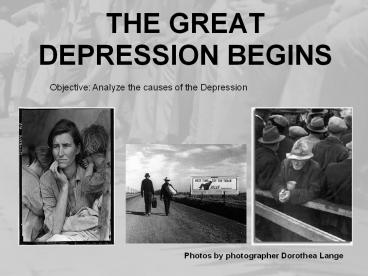THE GREAT DEPRESSION BEGINS - PowerPoint PPT Presentation
Title:
THE GREAT DEPRESSION BEGINS
Description:
THE GREAT DEPRESSION BEGINS Objective: Analyze the causes of the Depression Photos by photographer Dorothea Lange SECTION 1: THE NATION S SICK ECONOMY Agriculture ... – PowerPoint PPT presentation
Number of Views:464
Avg rating:3.0/5.0
Title: THE GREAT DEPRESSION BEGINS
1
THE GREAT DEPRESSION BEGINS
Objective Analyze the causes of the Depression
Photos by photographer Dorothea Lange
2
SECTION 1 THE NATIONS SICK ECONOMY
As the 1920s advanced, serious problems
threatened the economy while Important industries
struggled, including
- Agriculture
- Railroads
- Textiles
- Steel
- Mining
- Lumber
- Automobiles
- Housing
- Consumer goods
3
FARMERS STRUGGLE
- No industry suffered as much as agriculture
- During World War I European demand for American
crops soared - After the war demand plummeted
- Farmers increased production sending prices
further downward
Photo by Dorothea Lange
4
CONSUMER SPENDING DOWN
- By the late 1920s, American consumers were buying
less - Rising prices, stagnant wages and overbuying on
credit were to blame - Most people did not have the money to buy the
flood of goods factories produced
5
GAP BETWEEN RICH POOR
- The gap between rich and poor widened
- The wealthiest 1 saw their income rise 75
- The rest of the population saw an increase of
only 9 - More than 70 of American families earned less
than 2500 per year
Photo by Dorothea Lange
6
HOOVER WINS 1928 ELECTION
- Republican Herbert Hoover ran against Democrat
Alfred E. Smith in the 1928 election - Hoover emphasized years of prosperity under
Republican administrations - Hoover won an overwhelming victory
7
(No Transcript)
8
Young Hoover supporter in 1928
9
THE STOCK MARKET
- By 1929, many Americans were invested in the
Stock Market - The Stock Market had become the most visible
symbol of a prosperous American economy - The Dow Jones Industrial Average was the
barometer of the Stock Markets worth - The Dow is a measure based on the price of 30
large firms
10
STOCK PRICES RISE THROUGH THE 1920s
- Through most of the 1920s, stock prices rose
steadily - The Dow reached a high in 1929 of 381 points
(300 points higher than 1924) - By 1929, 4 million Americans owned stocks
New York Stock Exchange
11
SEEDS OF TROUBLE
- By the late 1920s, problems with the economy
emerged - Speculation Too many Americans were engaged in
speculation buying stocks bonds hoping for a
quick profit - Margin Americans were buying on margin
paying a small percentage of a stocks price as a
down payment and borrowing the rest
The Stock Markets bubble was about to break
12
THE 1929 CRASH
- In September the Stock Market had some unusual up
down movements - On October 24, the market took a plunge . . .the
worst was yet to come - On October 29, now known as Black Tuesday, the
bottom fell out - 16.4 million shares were sold that day prices
plummeted - People who had bought on margin (credit) were
stuck with huge debts
13
By mid-November, investors had lost about 30
billion
14
(No Transcript)
15
Stock Market
- The Stock Market crash signaled the beginning of
the Great Depression - The Great Depression is generally defined as the
period from 1929 1940 in which the economy
plummeted and unemployment skyrocketed - The crash alone did not cause the Great
Depression, but it hastened its arrival
Alabama family, 1938 Photo by Walter Evans
16
FINANCIAL COLLAPSE
- After the crash, many Americans panicked and
withdrew their money from banks - Banks had invested in the Stock Market and lost
money - In 1929- 600 banks fail
- By 1933 11,000 of the 25,000 banks nationwide
had collapsed
Bank run 1929, Los Angeles
17
GNP DROPS, UNEMPLOYMENT SOARS
- Between 1928-1932, the U.S. Gross National
Product (GNP) the total output of a nations
goods services fell nearly 50 from 104
billion to 59 billion - 90,000 businesses went bankrupt
- Unemployment leaped from 3 in 1929 to 25 in
1933
18
HAWLEY-SMOOT TARIFF
- The U.S. was not the only country gripped by the
Great Depression - Much of Europe suffered throughout the 1920s
- In 1930, Congress passed the toughest tariff in
U.S. history called the Hawley- Smoot Tariff - It was meant to protect U.S. industry yet had the
opposite effect - Other countries enacted their own tariffs and
soon world trade fell 40
19
CAUSES OF THE GREAT DEPRESSION
- Tariffs war debt policies
- U.S. demand low, despite factories producing more
- Farm sector crisis
- Easy credit
- Unequal distribution of income































